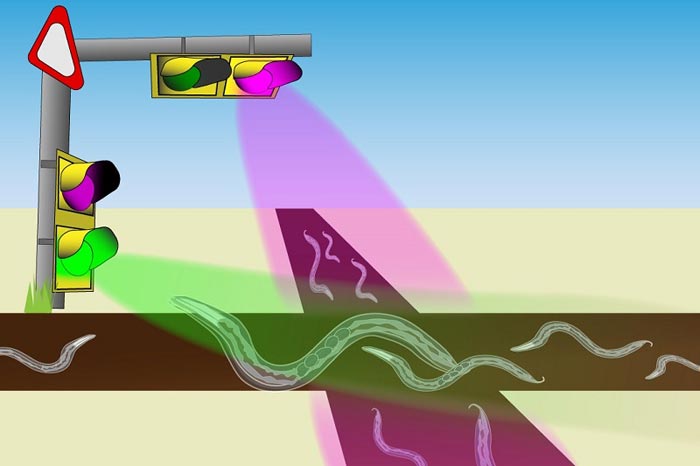Green means GO! Ultra-violet means STOP!

C. elegans Stoplight: OMU scientists have developed a system that can control the behavior of the nematode worm Caenorhabditis elegans, using two different light-sensitive proteins called opsins that are triggered by green and UV lights. The opsins are highly sensitive and can be switched on and off repeatedly, a property that is highly relevant to many avenues of biological research and the development of targeted drug treatments.
Creit: Osaka Metropolitan University
Is it possible to control an animal’s or a cell’s behavior using light? In recent years, remarkable progress in optogenetics has been made as research methods come close to realizing this goal.
A research group led by Professors Mitsumasa Koyanagi and Akihisa Terakita of the Graduate School of Science, and Professor Eriko Kage-Nakadai of the Graduate School of Human Life and Ecology at Osaka Metropolitan University has revealed a new system that allows them to control the behavior of the nematode worm Caenorhabditis elegans, using two different light-sensitive proteins called opsins.
A light-sensitive opsin isolated from mosquitos was introduced into C. elegans‘ sensory cells responsible for avoidance behavior that makes the worm move away after sensing a chemical or physical stimulus. The group found that exposing the worms to white light triggered this avoidance behavior, with a sensitivity approximately 7,000 times higher than that observed with channelrhodopsin-2, a common optogenetic protein.
Likewise, a UV-sensitive opsin first found in the pineal organ of lampreys was introduced into motor neurons of C. elegans. After that the worms stopped moving when exposed to UV light and began moving again when exposed to green light. This stop-start behavior was repeated many times, switching between the UV and green lights, indicating that the opsin could be switched on and off without destroying the protein.
“Both the mosquito and lamprey opsins we used are members of the G protein-coupled receptor (GPCR) family of receptors—which are used to sense various stimuli including smell, taste, hormones, and neurotransmitters—demonstrating that this system using light can be used to manipulate various GPCRs and their subsequent intracellular signaling and physiological responses,” said Professor Koyanagi.
Importantly, both opsins tested are bistable, meaning they can switch between stable forms when active and inactive without photobleaching or breaking down, allowing them to be used again after absorbing a different wavelength of light. The difference between the wavelengths of UV and green lights is large enough that inactive UV-sensitive opsin can recover, allowing for color-dependent on-and-off optogenetic control of GPCR signaling.
“The high-performance optogenetic tool based on bistable animal GPCR opsins reported here is a breakthrough, not only in a wide range of biological research, but might contribute to the field of drug discoverywhere it has already received considerable attention,” concluded Professor Terakita.
Funding
This work was supported in part by grants-in-aid for Scientific Research from the Japanese Ministry of Education, Science, Sports and Culture 18H02482, 20K21433, 21H00435, 15H05777, 20K21434; Japan Science and Technology Agency (JST) Precursory Research for Embryonic Science and Technology (PRESTO) Grant JPMJPR13A2 and JST Core Research for Evolutional Science and Technology (CREST) Grant JPMJCR1753.
About OMU
Osaka Metropolitan University is a new public university established in April 2022, formed by a merger between Osaka City University and Osaka Prefecture University. For more research news, visit https://www.upc-osaka.ac.jp/new-univ/en-research/research/ or follow us on Twitter: @OsakaMetUniv_en, or on Facebook.
All latest news from the category: Life Sciences and Chemistry
Articles and reports from the Life Sciences and chemistry area deal with applied and basic research into modern biology, chemistry and human medicine.
Valuable information can be found on a range of life sciences fields including bacteriology, biochemistry, bionics, bioinformatics, biophysics, biotechnology, genetics, geobotany, human biology, marine biology, microbiology, molecular biology, cellular biology, zoology, bioinorganic chemistry, microchemistry and environmental chemistry.
Newest articles

First-of-its-kind study uses remote sensing to monitor plastic debris in rivers and lakes
Remote sensing creates a cost-effective solution to monitoring plastic pollution. A first-of-its-kind study from researchers at the University of Minnesota Twin Cities shows how remote sensing can help monitor and…

Laser-based artificial neuron mimics nerve cell functions at lightning speed
With a processing speed a billion times faster than nature, chip-based laser neuron could help advance AI tasks such as pattern recognition and sequence prediction. Researchers have developed a laser-based…

Optimising the processing of plastic waste
Just one look in the yellow bin reveals a colourful jumble of different types of plastic. However, the purer and more uniform plastic waste is, the easier it is to…



